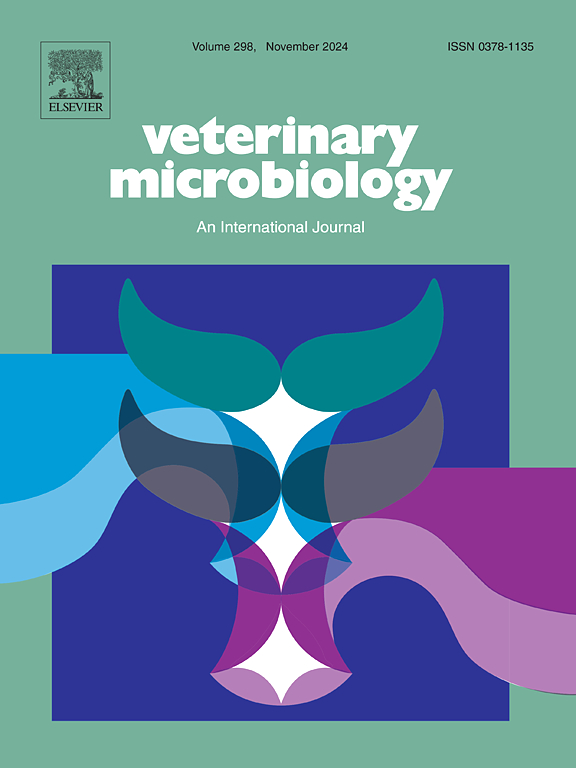Novel L1A/C RFLP 1–3-4 porcine reproductive and respiratory syndrome virus causing severe intestinal infections in China
IF 2.4
2区 农林科学
Q3 MICROBIOLOGY
引用次数: 0
Abstract
Porcine reproductive and respiratory syndrome (PRRS), caused by the PRRS virus (PRRSV), is one of the most economically significant swine diseases globally. In recent years, Lineage 1 (L1) PRRSV strains, including RFLP 1–3–4, RFLP 1–4–4, and RFLP 1–7–4, have emerged and spread widely in the United States, whereas the L1 RFLP 1–3–4 strain has been relatively rarely reported in China. In this study, three novel recombinant PRRSV variants, named TJ2401 (lineages 1.5, 1.8, and 8) with an L1A RFLP 1–3–4 pattern, TJ2402 (lineages 1.8 and 8) with an L1C RFLP 1–3–4 pattern and L1C TJ2406 (lineages 8.1, 8.2, and 1.8), were isolated from three distinct local pig farms in China in 2024. Experiments on 6-week-old piglets have demonstrated that the three isolated strains can induce severe interstitial pneumonia. Notably, both the TJ2401 strain and the TJ2402 strain exhibiting the RFLP 1–3–4 pattern can elicit typical clinical symptoms of diarrhea. Concurrently, high viral loads were detected in their fecal samples, aligning with the clinical signs of diarrhea. However, the TJ2406 isolated strain did not manifest typical diarrhea symptoms. Based on clinical observations and pathogenicity experiments, we have confirmed that these novel L1A/C 1–3–4 variants exhibit extensive tissue tropism, particularly in intestinal tissues. These results indicate the urgent need for comprehensive epidemiological surveillance and the development of new strategies to prevent the further spread of the disease.
中国引起严重肠道感染的新型L1A/C RFLP 1-3-4猪繁殖与呼吸综合征病毒
猪繁殖与呼吸综合征(PRRS)是由猪繁殖与呼吸综合征病毒(PRRSV)引起的猪繁殖与呼吸综合征,是全球最具经济意义的猪疾病之一。近年来,谱系1 (L1)型PRRSV毒株包括RFLP 1-3-4、RFLP 1-4-4和RFLP 1-7-4在美国出现并广泛传播,而L1型RFLP 1-3-4毒株在中国报道相对较少。本研究于2024年从中国三个不同的地方猪场分离到三种新的重组PRRSV变体,分别命名为TJ2401(谱系1.5、1.8和8)、TJ2402(谱系1.8和8)和TJ2406(谱系8.1、8.2和1.8),它们具有L1A RFLP 1-3-4模式,L1C RFLP 1-3-4模式。在6周龄仔猪上进行的实验表明,这三种分离菌株可诱发严重的间质性肺炎。值得注意的是,TJ2401菌株和TJ2402菌株均表现为RFLP 1-3-4模式,可引起典型的腹泻临床症状。同时,在他们的粪便样本中检测到高病毒载量,与腹泻的临床症状一致。但分离株TJ2406未表现出典型的腹泻症状。基于临床观察和致病性实验,我们已经证实这些新的L1A/C 1-3-4变异具有广泛的组织亲和性,特别是在肠道组织中。这些结果表明,迫切需要进行全面的流行病学监测和制定新的战略,以防止疾病的进一步传播。
本文章由计算机程序翻译,如有差异,请以英文原文为准。
求助全文
约1分钟内获得全文
求助全文
来源期刊

Veterinary microbiology
农林科学-兽医学
CiteScore
5.90
自引率
6.10%
发文量
221
审稿时长
52 days
期刊介绍:
Veterinary Microbiology is concerned with microbial (bacterial, fungal, viral) diseases of domesticated vertebrate animals (livestock, companion animals, fur-bearing animals, game, poultry, fish) that supply food, other useful products or companionship. In addition, Microbial diseases of wild animals living in captivity, or as members of the feral fauna will also be considered if the infections are of interest because of their interrelation with humans (zoonoses) and/or domestic animals. Studies of antimicrobial resistance are also included, provided that the results represent a substantial advance in knowledge. Authors are strongly encouraged to read - prior to submission - the Editorials (''Scope or cope'' and ''Scope or cope II'') published previously in the journal. The Editors reserve the right to suggest submission to another journal for those papers which they feel would be more appropriate for consideration by that journal.
Original research papers of high quality and novelty on aspects of control, host response, molecular biology, pathogenesis, prevention, and treatment of microbial diseases of animals are published. Papers dealing primarily with immunology, epidemiology, molecular biology and antiviral or microbial agents will only be considered if they demonstrate a clear impact on a disease. Papers focusing solely on diagnostic techniques (such as another PCR protocol or ELISA) will not be published - focus should be on a microorganism and not on a particular technique. Papers only reporting microbial sequences, transcriptomics data, or proteomics data will not be considered unless the results represent a substantial advance in knowledge.
Drug trial papers will be considered if they have general application or significance. Papers on the identification of microorganisms will also be considered, but detailed taxonomic studies do not fall within the scope of the journal. Case reports will not be published, unless they have general application or contain novel aspects. Papers of geographically limited interest, which repeat what had been established elsewhere will not be considered. The readership of the journal is global.
 求助内容:
求助内容: 应助结果提醒方式:
应助结果提醒方式:


